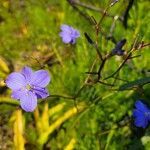A herb that keeps growing from year to year. It has tuberous roots. These can be 1-7 cm long. The leaves are narrow and in groups of 2-6. They are 5-13 cm long and 1.5-5 mm wide. There can be fine hairs along the edge. The flowering stalk is 25 cm long. There are 1-6 flowers on a stalk. The fruit is a capsule 8 mm across.

